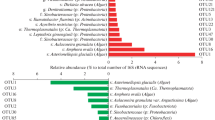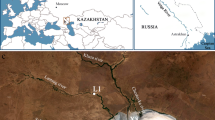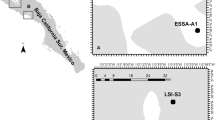Abstract
The main goal of this work was to determine which methanogens were present during the anaerobic degradation of Microcystis biomass in the water columns of freshwater lakes. Simulation experiments were performed in which 30 ml Microcystis slurries were anaerobically incubated in 60 ml airtight bottles at three temperatures (15, 25, and 35 °C) for over 90 days. The production of CH4 was monitored, and the methanogenic community was analyzed by cloning and sequencing the mcrA genes in samples incubated at the three different temperatures. In total, four clusters were detected at different temperatures by phylogenetic analysis of mcrA genes; these included members of Methanomicrobiales, Methanobacteriaceae, and Methanosarcina. An apparent linkage between temperature and phylogeny of the methanogenic community was observed: Methanomicrobiales and Methanobacteriaceae dominated the incubation system at the lower temperatures of 15 and 25 °C, whereas Methanosarcina prevailed at 35 °C. The dominance of these hydrogenotrophic methanogens suggested that, at least at lower temperatures, H2 and CO2 might be the primary substrates for CH4 production during Microcystis anaerobic decomposition.


Similar content being viewed by others
References
Bastviken D, Tranvik LJ, Downing JA et al (2011) Freshwater methane emissions offset the continental carbon sink. Science 331:50
Bokranz M, Bäumner G, Allmansberger R et al (1988) Cloning and characterization of the methyl coenzyme M reductase genes from Methanobacterium thermoautotrophicum. J Bacteriol 170:568–577
Castro H, Ogram A, Reddy KR (2004) Phylogenetic characterization of methanogenic assemblages in eutrophic and oligotrophic areas of the Florida Everglades. Appl Environ Microbiol 70:6559–6568
Chao A, Chazdon RL, Colwell RK et al (2005) A new statistical approach for assessing similarity of species composition with incidence and abundance data. Ecol Lett 8:148–159
Chen Y, Qin B, Teubner K et al (2003) Long-term dynamics of phytoplankton assemblages: Microcystis-domination in Lake Taihu, a large shallow lake in China. J Plankton Res 25:445–453
Conrad R, Claus P (2009) Characterization of stable isotope fractionation during methane production in the sediment of a eutrophic lake, Lake Dagow, Germany. Limnol Oceanogr 54:457–471
Grossart H-P, Frindte K, Dziallas C et al (2011) Microbial methane production in oxygenated water column of an oligotrophic lake. Proc Natl Acad Sci USA 108:19657–19661
Groβkopf R, Janssen PH, Liesack W (1998) Diversity and structure of the methanogenic community in anoxic rice paddy soil microcosms as examined by cultivation and direct 16S rRNA gene sequence retrieval. Appl Environ Microbiol 64:960–969
Hales B, Edwards C, Ritchie D et al (1996) Isolation and identification of methanogen-specific DNA from blanket bog peat by PCR amplification and sequence analysis. Appl Environ Microbiol 62:668–675
Hallam SJ, Girguis PR, Preston CM et al (2003) Identification of methyl coenzyme M reductase a (mcrA) genes associated with methane-oxidizing archaea. Appl Environ Microbiol 69:5483–5491
Høj L, Olsen RA, Torsvik VL (2008) Effects of temperature on the diversity and community structure of known methanogenic groups and other archaea in high Arctic peat. ISME J 2:37–48
Larkin MA, Blackshields G, Brown NP et al (2007) Clustal W and Clustal X version 2.0. Bioinformatics 23:2947–2948
Li H, Xing P, Chen M et al (2011) Short-term bacterial community composition dynamics in response to accumulation and breakdown of Microcystis blooms. Water Res 43:1702–1710
Lovley DR, Ferry JG (1985) Production and consumption of H2 during growth of Methanosarcina spp. on acetate. Appl Environ Microbiol 49:247–249
Luton PE, Wayne JM, Sharp RJ et al (2002) The mcrA gene as an alternative to 16S rRNA in the phylogenetic analysis of methanogen populations in landfill. Microbiology 148:3521–3530
Paerl HW, Huisman J (2008) Blooms like it hot. Science 320:57–58
Schloss PD, Handelsman J (2005) Introducing DOTUR, a computer program for defining operational taxonomic units and estimating species richness. Appl Environ Microbiol 71:1501–1506
Schnürer A, Schink B, Svensson BH (1996) Clostridium ultunense sp. nov., a mesophilic bacterium oxidizing acetate in syntrophic association with a hydrogenotrophic methanogenic bacterium. Int J Syst Bacteriol 46:1145–1152
Schwarz JIK, Eckert W, Conrad R (2008) Response of the methanogenic microbial community of a profundal lake sediment (Lake Kinneret, Israel) to algal deposition. Limnol Oceanogr 53:113–121
Springer E, Sachs MS, Woese CR et al (1995) Partial gene-sequences for the A subunit of methyl-coenzyme M reductase (mcrI) as a phylogenetic tool for the family Methanosarcinaceae. Int J Syst Bacteriol 45:554–559
Steinberg LM, Regan JM (2008) Phylogenetic comparison of the methanogenic communities from an acidic, oligotrophic fen and an anaerobic digester treating municipal wastewater sludge. Appl Environ Microbiol 74:6663–6671
Steinberg LM, Regan JM (2009) mcrA-targeted real-time quantitative PCR method to examine methanogen communities. Appl Environ Microbiol 75:4435
Tamura K, Dudley J, Nei M et al (2007) MEGA4: molecular evolutionary genetics analysis (MEGA) software version 4.0. Mol Biol Evol 24:1596–1599
Wang H, Lu J, Wang W et al (2006) Methane fluxes from the littoral zone of hypereutrophic Taihu lake China. J Geophys Res 111:D17109
Xing P, Guo L, Tian W et al (2011) Novel Clostridium populations involved in the anaerobic degradation of Microcystis blooms. ISME J 5:792–800
Acknowledgments
We thank Xing Jin and Chengsheng Long for their assistance in conducting the entire experiment. This work was supported by the National Basic Research Program of China (973 program) (No. 2008CB418104) and the National Natural Science Foundation of China (No. 31000241).
Author information
Authors and Affiliations
Corresponding author
Electronic supplementary material
Below is the link to the electronic supplementary material.
Rights and permissions
About this article
Cite this article
Xing, P., Zheng, J., Li, H. et al. Methanogen genotypes involved in methane formation during anaerobic decomposition of Microcystis blooms at different temperatures. World J Microbiol Biotechnol 29, 373–377 (2013). https://doi.org/10.1007/s11274-012-1191-2
Received:
Accepted:
Published:
Issue Date:
DOI: https://doi.org/10.1007/s11274-012-1191-2




